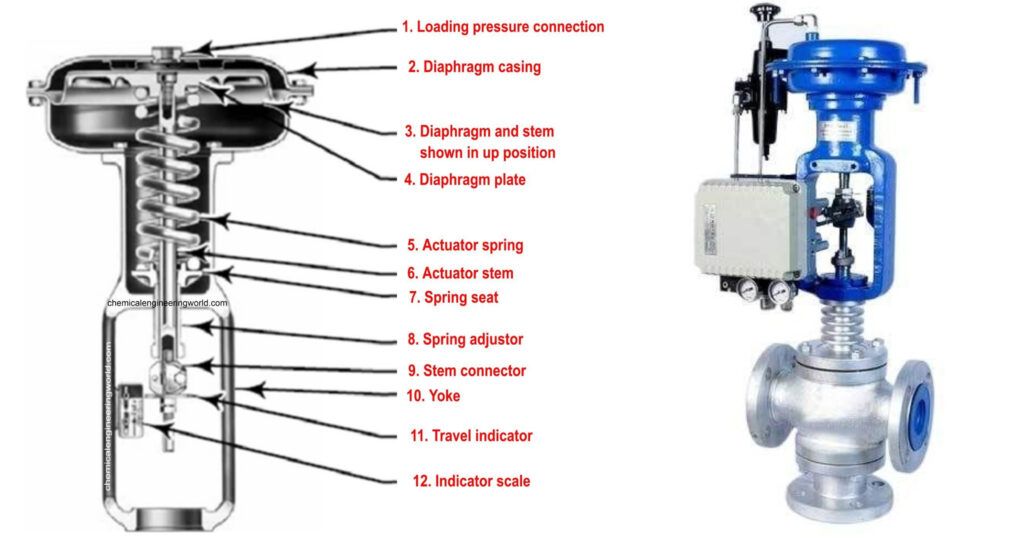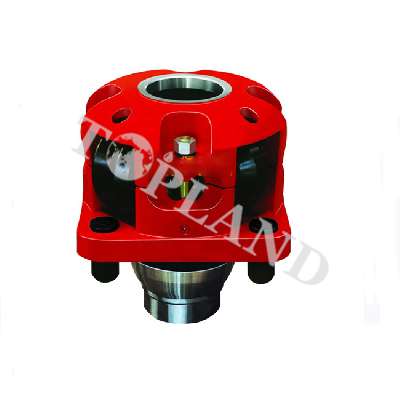CONTROL VALVE WORKING,COMPONETS & TYPES

Control Valve working, Components & Types:- A control valve is used as a final control element in a closed loop system to automate specific processes which involves transportation of fluids from one place to another. It is a device which is used to control the flow rate of the fluid by varying the size of the flow passages. The size of the flow passages is dictated by a signal which can neither be pneumatic, hydraulic or electrical in nature. The flow rate of a flowing fluid is controlled directly using a control valve using which process quantities such as liquid level, temperature and pressure can be controlled indirectly. They can be seen as consequences of the control action on the flow rate of the fluid. The signal instructions are given by a controller present in the closed control loop
Working of a Control Valve
The controller present in the closed loop feedback system of the process sends signal to the final control element, the control valve to instruct it how much to maintain the opening of the valve stem so as the flow rate can be increased, decreased or maintained at a steady state. If the signal is of pneumatic type then it corresponds to the range of 3-15 psig and if the signal is of electrical nature it corresponds to the range of 4-20 mA. A control valve operates is this range. In order to ensure that the valve stem position is changing as per the set point and the signal dictated by controller, a valve positioned is mounted near a valve assembly.
Components of a Control Valve
The main components of a control valve are the valve itself, the actuator and the valve positioner.
The valve:
This is the modulating element of the control valve within which a ball, plug, butterfly or plug is contained. The basic designs of the valve are of two types; a plug and seat design valve wherein a plug is pressed against a seat and a quarter turn valve wherein a ball, disc or cone is rotated and turned against a seat. The portion of the valve which regulates the flow is known as valve trim. Variety in designs of valve trims creates.
The actuator:
Its function is that it is used to move the valve stem. The moving action can be carried out either pneumatically, hydraulically or electrically. The air actuating valves are the simplest of the lot because they only require a supply of compressed air. The electrically actuated valves require additional cabling as well as a switch gear. The hydraulically actuated valves require high pressure supply lines and return lines as well for the hydraulic fluid.
Valve positioner:
A valve positioner’s function is to ensure that the position of the valve stem corresponds to the set point from the controller system. It requires the position feedback from the valve stem and it delivers pneumatic pressure to actuator to open or close the valve.
Types of Control Valves
The types can be various depending on the actuating medium used, functionality, movement profile of the controlling element.
Based on Actuating Medium used
Manual Valve:
They are not part of the automatic system of the process. They contain a hand wheel or a lever and are operated on by hand.
Pneumatic Valve:
They are actuated by a compressed material medium. The most common medium is Air. Other mediums like nitrogen, hydrocarbons, etc can also be used.
Hydraulic Valve:
They are actuated by a non-compressible material medium. The most common medium is usually water and sometime oil is also used.
Electric Valve:
They are actuated by an electric motor.
Based on Functionality of the valve
Proportional Control Valve:
The flow rate is controlled by an automatic proportional action based on the signal received by the controller. The valves which can be used are ball valve, globe valve, etc.
On-Off Valve:
The valve is either fully close or fully open. The valves which can be used are gate valve, ball valve, globe valve, etc
Check Valve:
Based on Movement profile of the Controlling Element
Sliding Stem:
It contains a plug and a seat setup. The valve stem and valve plug are one and the same thing. The plug slides in a linear motion. For example, globe valve, wedge valve. Etc.
Rotary Valve:
It contains a disc which under goes a rotary motion, the turning action results in a flow passage. For example, ball valve, butterfly valve, etc.




 Upload RFQ
Upload RFQ





 Twitter
Twitter Linkedin
Linkedin Facebook
Facebook YouTube
YouTube Sales@toplandoil.com
Sales@toplandoil.com +86 21-50890868
+86 21-50890868 Head Office: 8-1011,Lane 5600, Chuansha Road, Pudong, Shanghai, China
Head Office: 8-1011,Lane 5600, Chuansha Road, Pudong, Shanghai, China 